Thursday, 10 August, St. Petersburg: the Hermitage three ways and the ballet
Written 20 September 2017
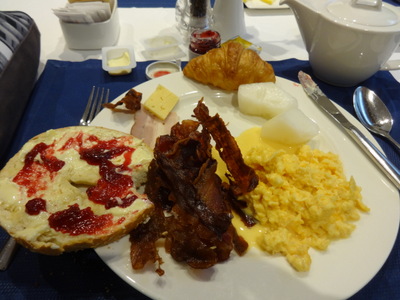
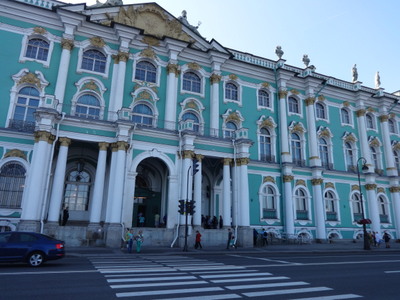 On Thursday morning, the scrambled eggs were especially good. Each morning, I would try a little. Some days they were great, others, not worth eating. Clockwise from the top: a minicroissant, a couple of cubes of Canary melon, scrambled eggs, bacon, half a bagel spread with butter and cherry jam, a little cold roast pork, and a small slice of Havarti cheese. At the top right, my pot of tea.
On Thursday morning, the scrambled eggs were especially good. Each morning, I would try a little. Some days they were great, others, not worth eating. Clockwise from the top: a minicroissant, a couple of cubes of Canary melon, scrambled eggs, bacon, half a bagel spread with butter and cherry jam, a little cold roast pork, and a small slice of Havarti cheese. At the top right, my pot of tea.
We were up and out early because our day's tour left at 8:00 a.m. When we wigned up for the cruise, we were given the choice between the ordinary Hermitage tour (9:30 a.m. to 2:30 p.m.) and (for an additional fee) the "privileged access" tour (8:00 a.m. to 5 p.m.). The folks who left at 9:30 were offered pieces of fruit to take with them because lunch would be so late. We weren't because we would be having lunch out.
At the right here is the main entrance to the Winter Palace, one of the Hermitage's three main buildings, but before we got there, we learned a lot on the bus. The reason we left early is that Viking has a deal with the museum that got us in an hour and a half before regular opening time. Our guide Galina was great.
- The original Winter Palace had 1057 rooms. It faces the Neva across a street. Catherine the Great (I think) added a hermitage off to one side, still facing the Neva, and she kept much of her art collection in there because it wouldn't all fit in the Winter Palace. The collection kept growing, and eventually another "small hermitage" was added in the space between the Winter Palace and the "old hermitage. Today, the three buildings have 12 miles of hallway. (Later, we were told 18 miles, but that may include outlying buildings.)
- We've been told various that the Hermitage owns 3 million items in total and that it has 3 million items on exhibition. Impressive either way.
- Traditionally, all large homeowners had home theaters, and serfs did the acting. Catherine the Great was the first to build a theater (in the Winter Palace) and to make all the nobles dress up and act.
- Almost all of the original collection was made by Romanovs, but Catherine expanded it the most.
- St. Petersburg has electric trolleys on rails in addition to trolley buses, but they're trying to remove all the tracks and convert entirely to trolley busses.
- St. Petersburg uses an excellent water-purification system. Its final stage involves female crayfish, which are apparently extremely sensitive to impurities. Unfortunately, this perfectly pure water is then piped through ancient and corroded pipes, so many residents drink only bottled water.
- In the Romanovs' time, during great celebrations,the fountains in the palace gardens (normally gravity-driven water fountains) were made to play red and white wine instead.
- The granite and wrought-iron fence around the gardens, which is considered the best proportioned in the city was designed by a son of the palace cook, named Felton. At some point, foreigners offered Russia 100 locomotives in exchange for the fence, but the ministry of culture declined.
- The monument to Alexander III looking dejected on a dejected-looking horse looks gloomy, but its solidity was meant to represent the country's financial stability.
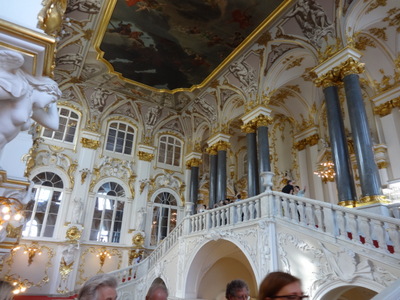
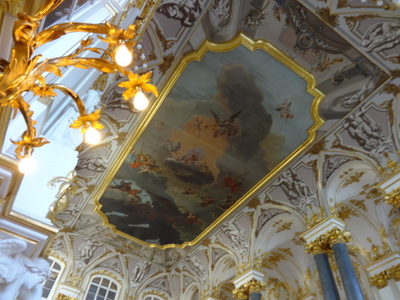 Again, the building itself was worth the price of admission before we even looked at the art! This is the Ambassador's Staiorcase in the entry hall and (to the right) its painted ceiling. All the gray "marble" statuary surrounding the central painted panel is "trompe l'oeil," i.e., painted on a flat surface to look three-dimensional. The staircase's design is 18th Century, but the decor was redone in the 19th century after a fire in 1837. The carved wood mouldings were replaced with gilded plaster, and wooden bannister replaced with marble.
Again, the building itself was worth the price of admission before we even looked at the art! This is the Ambassador's Staiorcase in the entry hall and (to the right) its painted ceiling. All the gray "marble" statuary surrounding the central painted panel is "trompe l'oeil," i.e., painted on a flat surface to look three-dimensional. The staircase's design is 18th Century, but the decor was redone in the 19th century after a fire in 1837. The carved wood mouldings were replaced with gilded plaster, and wooden bannister replaced with marble.
When the fire broke out, after the royal family was evacuated, everyone carried out everything they could save, where it was stacked in the square large square behind the palace and guarded until it could be moved someplace safer. At the time, about 3000 people lived in the palace in addition to the royal family. The entrance hall was actually divided into tiny cubicles in which the servants lived.
The servants' jobs were inherited father to son, and more of them lived in the attics, above the ceilings. In particular, the firemen lived up there, with their wives and children, and they even a cow to produce milk for the babies.
Some of the columns in the building are real marble, some are faced with real semiprecious stones, and some are painted wood with a shiny glaze to make them look like marble. I don't remember which these are.
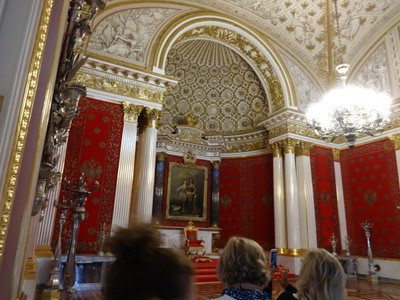
 Again, some of the rooms were named for function, but others by decor. I don't remember which this one was, but I think of it as the red room.
Again, some of the rooms were named for function, but others by decor. I don't remember which this one was, but I think of it as the red room.
The parquet in this palace was even more elaborate than that in the Catherine Palace and again was different in every room. Galina explained why we had to wear slippers there but not here. The parquet there is much thinner and in addition has been restored, i.e., ground down to resmooth the surface, so they don't want to risk any greater wear on it.
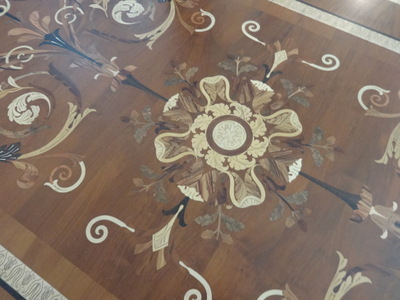
 In the winter palace, they are thicker and more solid. After the war, they were .resanded and impregnated with a lacquer, so they're much less subject to wear.
In the winter palace, they are thicker and more solid. After the war, they were .resanded and impregnated with a lacquer, so they're much less subject to wear.
The makers of the floors didn't have ebony, so to get black, they soaked selected logs in particular streams (with suitable mineral content) and dried them years. Sometimes .30 years of preparation (soaking, drying, etc.) were needed before the wood could be cut and the parquet assembled. The white is probably birch. For colors they couldn't produce locally, they brought wood from India and South America.
The long preparation and seasoning of the wood is the reason these floors, even though they are all original, show no shrinkage, warping, or cracks. During the seige of the city, they were covered with a layer of sand.
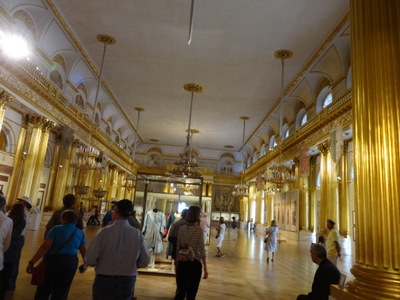
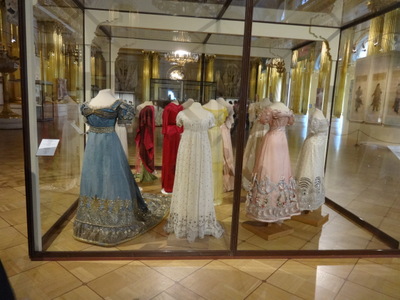 This room is the Armorial Hall. Regilding a room like this takes 7 to 9 kilos of gold leaf. The decor of the palace also uses up to 200 different shades of color of jasper.
This room is the Armorial Hall. Regilding a room like this takes 7 to 9 kilos of gold leaf. The decor of the palace also uses up to 200 different shades of color of jasper.
The hall is now used to display period clothing. During times when fashion dictated tiny waists, some of the women even had a lower rib surgically removed, so they could be more tightly corsetted. (I understand Cher had that procedure, too, in search of a "more boyish profile.")
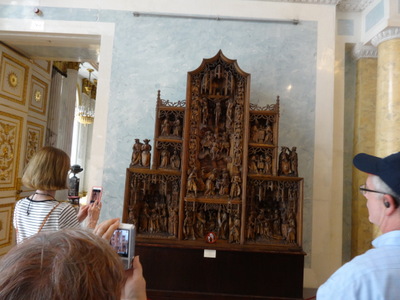
 Here's a rare wooden altarpiece. Remember, from the monastery tour, that wood carving fell out of favor, so not much of it is left.
Here's a rare wooden altarpiece. Remember, from the monastery tour, that wood carving fell out of favor, so not much of it is left.
The long gallery at the right looks out over the river. I think it's the one called the Raphael gallery because the ceiling features Rafael's scenes from the bible.
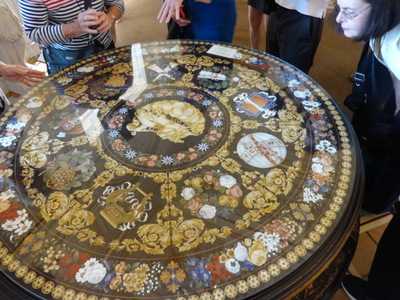
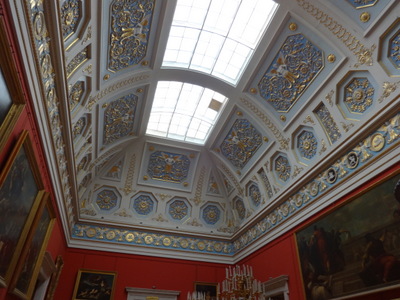 Mosaic tables showed got popular in the middle of the 18th century. This one, made of unbelievably small bits of oxidized metals and glass is displayed in Catherine the Great's private appartments. Another nearby was made of bits of natural stone.
Mosaic tables showed got popular in the middle of the 18th century. This one, made of unbelievably small bits of oxidized metals and glass is displayed in Catherine the Great's private appartments. Another nearby was made of bits of natural stone.
This was the room where sections of parquet (of different sizes for different occasions) sank down and slid aside so that a completely set and served table (sized for from 3 to 17 people) could rise into place. Little dumbwaiters allowed guests to send down a plate with a little chit of paper on it to order more food.

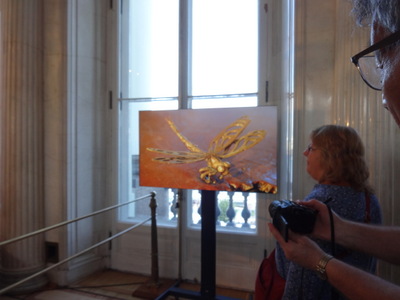
Also in Catherine's private quarters was what I consider the most spectacular item in the building—the peacock clock. It was a gift to Catherine from her lover at the time; it arrived in a zillion tiny carefully packed pieces, and it took a gifted mechanic and inventor two years to put it together and get it to work.
The clock still works but is only occasionally wound. Next to the case is a video screen showing it in operation. The photo at the right is a shot of the screen showing a close-up of the tiny dragonfly that indicates the minutes. The animals are life size and include the peacock, an owl in a cage, a cock, a squirrel, a fox, and a dragonfly. On the hour, the peacock moves its head, spreads its tail, and turns around; the cock crows; the little caged owl moves its head, and its cage spins, playing a tune on tiny bells hanging from its bars. If you Google "peacock clock hermitage," you can find videos of it in operation, both the official one and others taken by tourists.
We were told that When Catherine and her friends gathered here to play cards, the only acceptable currency in which debts could be paid was diamonds.
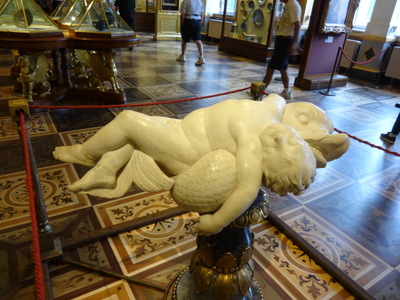
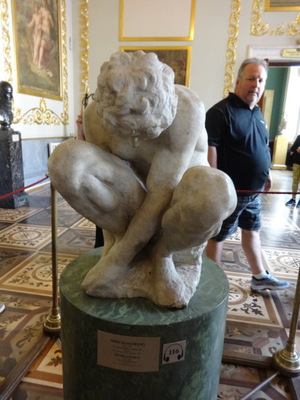 So in addition to all this decor, we also saw some actual art. At the left here is a boy asleep in the coils of a dolphin, attributed to Lorenzo Lorenzetto.
So in addition to all this decor, we also saw some actual art. At the left here is a boy asleep in the coils of a dolphin, attributed to Lorenzo Lorenzetto.
At the right is the Crouching Boy by Michelangelo (unfinished, I think.

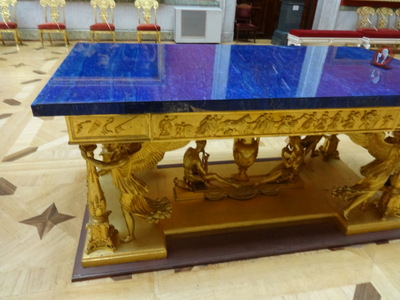 Vases and other decorative and useful objects carved from solid blocks of semiprecious stones were popular, and the place is full of them. Here is a vase in green jasper. At the right is a table top in lapis lazuli.
Vases and other decorative and useful objects carved from solid blocks of semiprecious stones were popular, and the place is full of them. Here is a vase in green jasper. At the right is a table top in lapis lazuli.
In another room, we saw a quartet of monumental columns faced in the same brilliant blue stone.
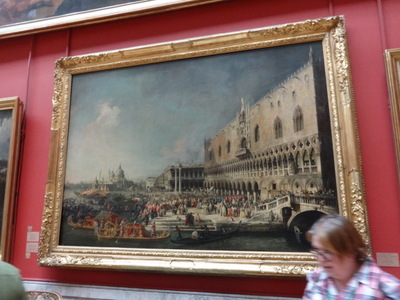
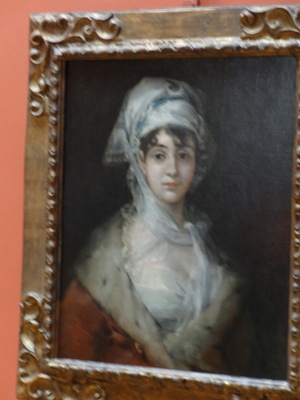 At the left here is a wonderful Canaletto (I love Canaletto).
At the left here is a wonderful Canaletto (I love Canaletto).
At the right is the Hermitage's only Goya, Portrait of the actress Antonia Zárate. It's famous (among other reasons) because the eyes seem to follow you around the room, no matter where you stand. I tried it, and it's true.

 At the left here is a Rembrandt, Christ and the Woman of Samaria. Nearby is the last (and the largest) painting that Rembrandt ever produced, but it's very dark and difficult to see. They can't restore the bright colors because Rembrandgt covered it with a lacquer that has the same solvent as the paint, apparently a common problem with paintings of this period. The lacquer darkens and can't be removed.
At the left here is a Rembrandt, Christ and the Woman of Samaria. Nearby is the last (and the largest) painting that Rembrandt ever produced, but it's very dark and difficult to see. They can't restore the bright colors because Rembrandgt covered it with a lacquer that has the same solvent as the paint, apparently a common problem with paintings of this period. The lacquer darkens and can't be removed.
At the right what is thought to be the largest vase ever carved from solid jasper. It's oval, and we're looking at the long side. Notice the size of the person standing under it. Just getting it here from Siberia, where it was quarried, took six months, and the room had to be built around it because it won't go through any of the doors.
I think the columns in this room were pointed out to us as an example of faux marble, painted on and glazed.

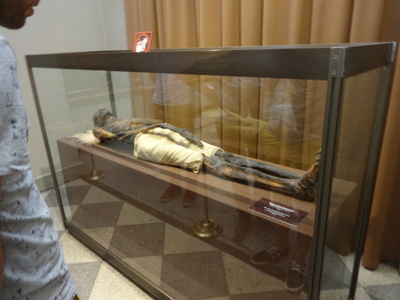 And of course, in addition to all the standard old masters, the Hermitage has ancient art and artifacts. At the left here is a Roman mosaic (probably a floor), and at the right an Egyptian mummy.
And of course, in addition to all the standard old masters, the Hermitage has ancient art and artifacts. At the left here is a Roman mosaic (probably a floor), and at the right an Egyptian mummy.
If I tried to describe and show all that we saw, I'd never finish this page, and we walked past only a small fraction of the museum's holdings. Here's a selection of other notes I took during the tour.
- About 2/3 of the contents of the Hermitage were evactuated to Siberia during World War II. The chandeliers were too heavy to be moved, so they were left in place. The largest chandelier is the one in the Marshall Hall.
- During the Soviet era, only 6% of Russians were members of the communist party.
- The throne room was also called the St. George room because of the bas-relief of St. George slaying the dragon above the throne. Strangely, St. George is the patron saint of both Russia and England.
- Outside the long gallery where we viewed religious objects and early Italian renaissance icons is a second-story rose garden, with another gallery beyond.
- In the Giorgione's painting of Judith with Holofernes's head under her foot, it's rumored that the artist made the head a self protrait.
- In a room full of Titians, we saw the painting of Danae, mother of Perseus, onto which a sabateur threw acid a few years ago. It's now back on display after 12 years of restoration). They were able to match and patch the canvas perfectly, then glued back the paint, which they had had to scrape off in little wrinkled sheets, but Galina said a lot of fine detail was lost. The museum is still very twitchy about letting anyone in who's carrying a water bottle.
- According to Galina, silver can be infected with a microorganism that can spread from one object to another, so they sometimes have to isolate infected ones. (I'm not sure I believe this. Does anybody out there know?
- One large gallery, with a gorgeous coffered ceiling surrounded by a red and gold frieze, displayed cases of china and majolica, but also many ornamental snuff boxes enclosed in little individual pyramidal glass cases.
- Another room had a blue, white, and gold Wedgewood frieze just below the ceiling. Yet another had a lapis lazuli jar of huge proportions.
- The Rembrandt "holy family" is actually a Rembrandt family protrait.
- The room with the mosaics on the floor also displayed a arge uniquely shaped Greek vase.
- Other outstanding objects we saw included da Vinci's Benois Madonna (just Google those words for a better photo than I got), a set of red and bronze doors inlaid with tortoise shell, Gulielmo della Porta's famous Spinario (where have I seen that before? I know I have), many suits of armor for people and for horses, and another Danae (this one by Rembrandt). In short, way too much to take in!
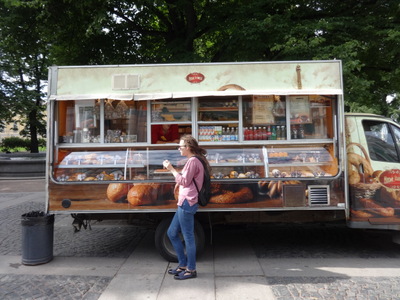
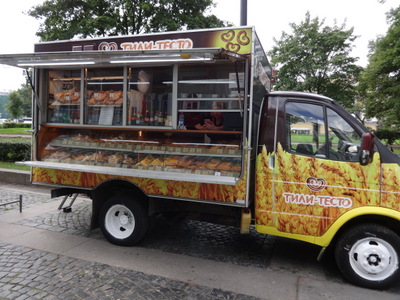
After our visit to the Winter Palace, Little Hermitage, and Old Hermitage, we walked outside and around the side of the Old Hermitage to Palace Square. On the way, we passed these food trucks (only two among many) selling breads, pastries (sweet and savory), sandwiches, hot dogs, coffee, and soft drinks.
I thought these looked the most appetizing. Others leaned more toward the hot-dog-and-soft-drink side, some trucks were selling clothing and souvenirs, and of course one was loaded with large kettles of hot sweet corn on the cob. It was usually speared endwise with a sturdy wooden stick to serve as a handle and presented to the customer in a tall paper cup, stick end up.
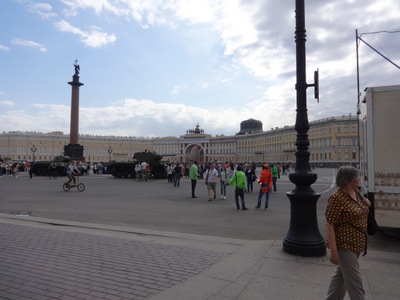
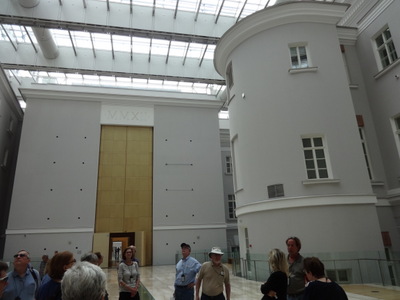 This is the large "square" (actually semicircular) that separates the back of the Hermitage from the front of the long curved General Staff Building, now property of the Hermitage (at least some of it; some may still be in military hands). It also housed the ministry of defense and ministry of finance. This is where the contents of the Hermitage were piled in the snow after being rescued from the fire. Among the tourists strolling around, you can see tanks, military trucks, and antiaircraft guns. You can't see them here, but we also saw structures intended to entangle and disable tanks (looking like 10-foot jacks from the game of ball and jacks). They were all left over from some sort of parade or demonstration a few days earlier, and the military folks seemed happy to have people pose for selfies with them and even climb on the tanks.
This is the large "square" (actually semicircular) that separates the back of the Hermitage from the front of the long curved General Staff Building, now property of the Hermitage (at least some of it; some may still be in military hands). It also housed the ministry of defense and ministry of finance. This is where the contents of the Hermitage were piled in the snow after being rescued from the fire. Among the tourists strolling around, you can see tanks, military trucks, and antiaircraft guns. You can't see them here, but we also saw structures intended to entangle and disable tanks (looking like 10-foot jacks from the game of ball and jacks). They were all left over from some sort of parade or demonstration a few days earlier, and the military folks seemed happy to have people pose for selfies with them and even climb on the tanks.
The Alexander Column in the center is topped by an angel with a cross. It was named for Alexander I, who was tsar during the Napoleonic wars. The chariot and horses over the central doorway is a copy of one displayed elsewhere. I've forgotten where, but it looks familar, so some of you readers probably recognize it.
The Hermitage's collection of impressionists and postimpressionists is displayed in the staff building, so that was the second phase of our tour. As you can see in the right-hand photo, the decor is rather different. The whole building was heavily renovated (and reinforced; all of St. Petersburg is on flat marshy ground, so a heavy building needs a lot of infrastructure to keep it from sinking, tilting, or cracking) in 2012. To make this building usable, they drove 1300 piles before restoring the inside; then, unexpectedly, the River Moika next door came up through the bottom of the building to form a fountain, so they started over, this time using injection piles. This photo is of the central atrium through which we entered.
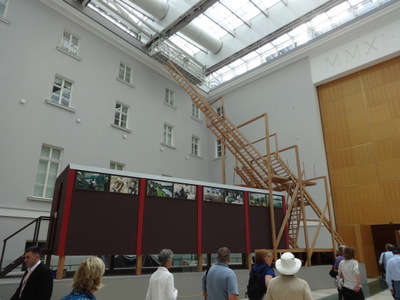
 The atrium is very large. It was once the open courtyard of the building; now it's glassed over.
Within it are displayed this complicated system of wooden ladders and a life-size metal statue of a young girl in the act of falling out of an overturned chair (right).
The atrium is very large. It was once the open courtyard of the building; now it's glassed over.
Within it are displayed this complicated system of wooden ladders and a life-size metal statue of a young girl in the act of falling out of an overturned chair (right).
At first, I thought the ladders were part of ongoing work on the building, but finally I concluded they must be a work of art in their own right. The sculpture of the girl must have been a bear to pose for!
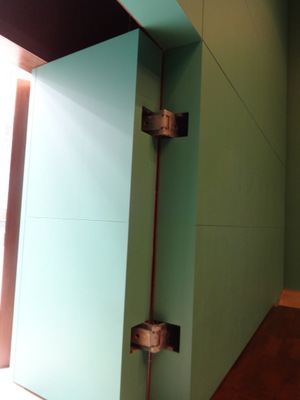
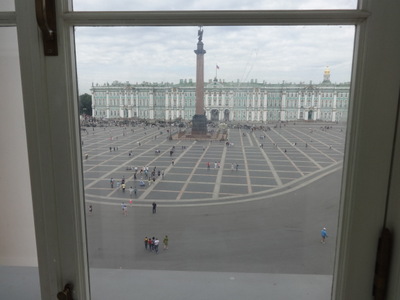 The walls were massive, as this doorway illustrates. The door and the wall it's hinged to are so thick that special "double-jointed" hinges are necessary for them to work at all. Like all buildings in Russia, this one has been put to many uses. Apparently during some restoration or reconstruction, it housed a lot of the construction workers and even livestock.
The walls were massive, as this doorway illustrates. The door and the wall it's hinged to are so thick that special "double-jointed" hinges are necessary for them to work at all. Like all buildings in Russia, this one has been put to many uses. Apparently during some restoration or reconstruction, it housed a lot of the construction workers and even livestock.
At the right is a view from a window overlooking the square. The Winter Palace is the wide green building behind the column. Behind the building is the Neva River.
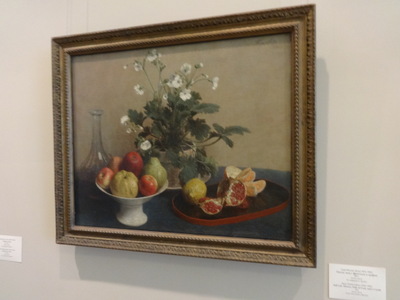
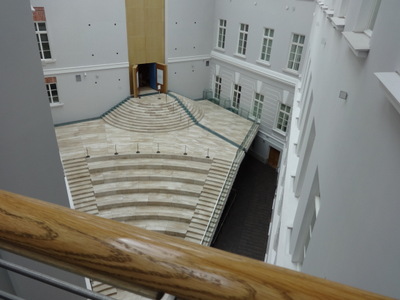 The collection displayed in this building is the other half of the Shchukin and Morozov collection from the Pushkin in Moscow.
The collection displayed in this building is the other half of the Shchukin and Morozov collection from the Pushkin in Moscow.
I was delighted to find half a room full of Henri Fantin Latour (1836–1904) still lives, like the one in the left-hand photo. He's one of my favorite still-life painters (and still life is my favorite genre); he does a particularly good job with roses.
We toured a (large) room of Monet, a room of Degas, a room of Renoirs, a couple of rooms of Cézanne, a couple rooms of Gaugin (the guide said that Gaugin got leprosy in the south-sea islands and died of it there), a couple of rooms of van Gogh, a few Derains, a whole raft of Matisses, some Picassos, at least one Seurat, and a few Kandinskys, all in addition to ones and two of paintings by other major artists. Wow!
The photo at the right shows the view from an upper floor of the atrium below. We entered the building at the bottom of the photo, then climbed all those stairs to enter the museum proper through the open door at the top. The ladders and falling girl are out of sight to the left.
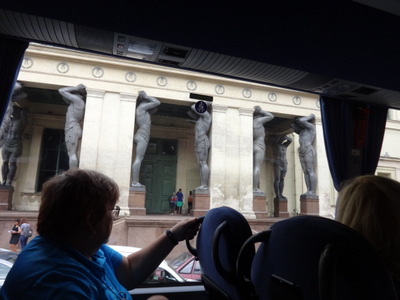
 Back in the bus for the third phase of our Hermitage tour (another part that the "regular" tour doesn't cover), we learned that the Neva is 74 km long and that 50 miles of it are in the city (why they give the two dimensions in different units, I have no idea). Also, the building next to the gloomy-looking statue of Alexander III was the Museum of Lenin until three days after communism fell. It was packed and emptied and taken over by the Bureau of Museum, which has offices there and occasionally uses it for temporary exhibitions.
Back in the bus for the third phase of our Hermitage tour (another part that the "regular" tour doesn't cover), we learned that the Neva is 74 km long and that 50 miles of it are in the city (why they give the two dimensions in different units, I have no idea). Also, the building next to the gloomy-looking statue of Alexander III was the Museum of Lenin until three days after communism fell. It was packed and emptied and taken over by the Bureau of Museum, which has offices there and occasionally uses it for temporary exhibitions.
On the way, we passed this building equipped with impressive Atlases as well as this large gray naval ship, the Aurora, now a museum.

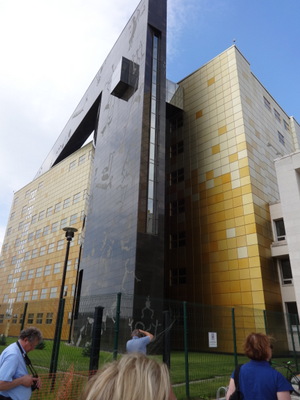 Our destination was this impressive building, shown here in two views, which houses some of the Hermitage's depositories of objects not displayed in the museum. This building contains 38 depositories, part of a total of 80.
Our destination was this impressive building, shown here in two views, which houses some of the Hermitage's depositories of objects not displayed in the museum. This building contains 38 depositories, part of a total of 80.
Security is impressive. Employees entering the building for the day go through electronic facial recognition and eyeball scanning, which activates their access cards for that day only. Every elevator, hallway, and individual room is locked and requires card access, so a guide who works at the depository accompanied us and Galina all the way, swiping us into each room.

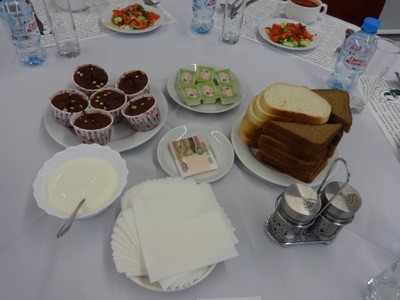 One wall of the lobby was mirrored (concealing agents looking for terrorists? no clue), which David took as an opportunity to smooth down his hair but Rachel and I took as an opportunity for an "old fashioned" selfie.
One wall of the lobby was mirrored (concealing agents looking for terrorists? no clue), which David took as an opportunity to smooth down his hair but Rachel and I took as an opportunity for an "old fashioned" selfie.
The first stop on our tour was lunch in the staff canteen, so we went up one floor. We used the small elevator, rated for 3.2 tons (tonnes?). The large one will take 10 tons.
In the canteen the tables were set up for us. In the center were a fanned stack of napkins, a plate of sliced bread, single-serve packets of butter, a bowl of sour cream, and a plate of chocolate cupcakes. In the center was a tip saucer, with a small bill in it as a hint.
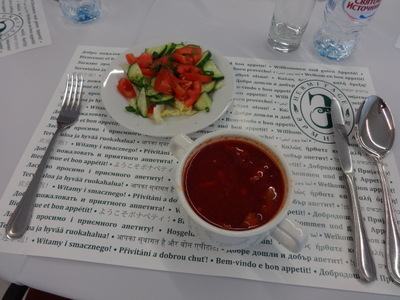
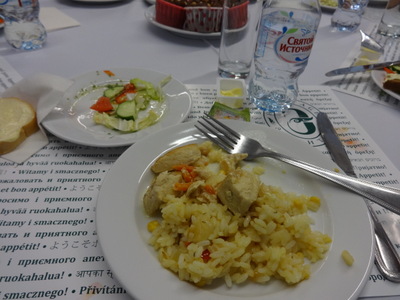 The first course was also already in place: a bowl of outstanding cold borscht (sorry, Viking; yours just doesn't measure up) and a tomato and cucumber salad with mixed fresh herbs. The paper placemat says "Welcome and bon appétit" in many languages, and the seal on it reads "Hermitage" in Roman and Cyrillic.
The first course was also already in place: a bowl of outstanding cold borscht (sorry, Viking; yours just doesn't measure up) and a tomato and cucumber salad with mixed fresh herbs. The paper placemat says "Welcome and bon appétit" in many languages, and the seal on it reads "Hermitage" in Roman and Cyrillic.
The main course was a tasty, mildly curried chicken and rice dish, shown here at the right. Dessert, of course, was chocolate cupcakes (topped with crunchy beads of pearl sugar) and self-serve coffee and tea.
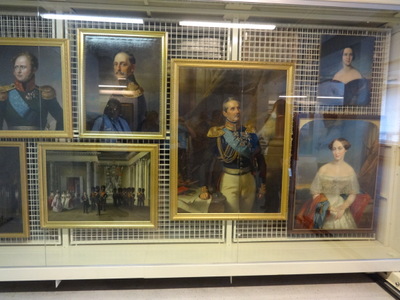
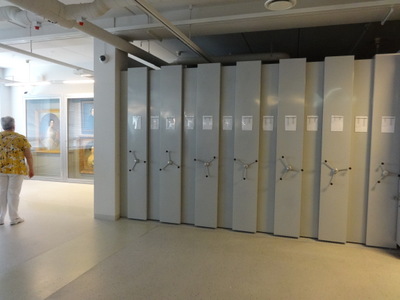 The first storeroom we visited was of paintings. They're hung on these double-sided movable racks. The photo at the right shows a whole stack of racks in "compact" configuration—face to face, without space between. Does Dirac Science Library at FSU still use stacks like these? To view any particular rack, you turn the three-handled wheel to slide the stack open at that point.
The first storeroom we visited was of paintings. They're hung on these double-sided movable racks. The photo at the right shows a whole stack of racks in "compact" configuration—face to face, without space between. Does Dirac Science Library at FSU still use stacks like these? To view any particular rack, you turn the three-handled wheel to slide the stack open at that point.
At the other end of the room, we were shown two large-format paintings depicting groups of people in rooms at the Hermitage that we had just visited. Also in this room was a modern painting, recognizable an image of two angels but otherwise looking as though they were by Jackson Pollock. It's the only painting in the collection by a still-living artist. He presented it to the museum himself. He lives in the U.S. but has a Russian name, which I didn't catch and can't figure out how to look up.
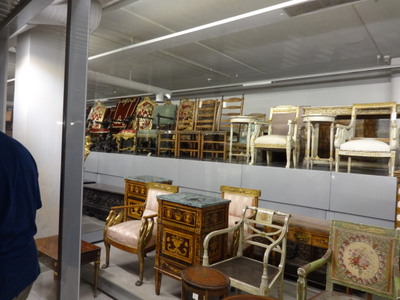
 In another depository were rows and rows and shelves and shelves of chairs, mixed in with other furniture, including some currently under restoration.
In another depository were rows and rows and shelves and shelves of chairs, mixed in with other furniture, including some currently under restoration.
One piece that particularly struck me was this early recliner. Not quite a Lazy Boy, but clearly headed that way.

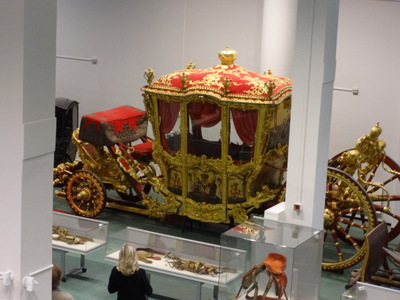 A couple of vast rooms were dedicated to carriages and wagons. A second-floor mezzanine exhibited smaller items (saddles, harnesses, bridles, and, yes, about half of an actual mummified horse found in a 4th century burial mound in Siberia) and afforded an upstairs view of the larger items below.
A couple of vast rooms were dedicated to carriages and wagons. A second-floor mezzanine exhibited smaller items (saddles, harnesses, bridles, and, yes, about half of an actual mummified horse found in a 4th century burial mound in Siberia) and afforded an upstairs view of the larger items below.
The golden and red coronation coach of Catherine I (right-hand photo) is the oldest, 1724. It was pulled by 8 white horses.

 The left-hand photo here is of the train only of a gown embroidered with silver—with real, very fine silver wire.
The left-hand photo here is of the train only of a gown embroidered with silver—with real, very fine silver wire.
A gown of Empress Alexandra's was actually made of silver thread; it weighed 10 kg, and the mantle added another 13 kg. She must have been in pretty good shape just to stand up in it and walk.
Other items of dress on display were kokoshniks (pron. kookooshniks), headdresses worn by unmarried women. We've heard about those throughout the trip, and I was glad finally to get the spelling right.
A few examples of tapestries were hung for display. Many more are stored rolled.
Finally, we visited the very large department of diplomatic gifts, among which we saw two north African tents presented to the Tsars. One was erected over a sort of greenhouse in which we stood to look at it from the inside and which protected it from our breath and our temptation to touch. Parts of it were made of cashmere, and it was impregnated with wax for waterproofing. Originally, the supports would have been wooden, and slots were sewn into the walls to receive the posts.
The right-hand photo shows a second, much larger and more elaborate tent from what's now Uzbekistan, presented ot Alexander II. It consisted of half a dozen rooms arranged around a central courtyard open to the sky and with a covered porch in front, 1200 square feet in all. The view in the photo is from inside one of the rooms, looking out into the courtyard. The band of yellow fabric around the bottom edge would have been folded inward, under the carpets spread to serve as the floor. All of its elaborate embroidery was done by men; only men were allowed to embroider with gold and silver threads. The large collection of north African embroidered carpets, on the other hand, were made by young unmarried women for their hope chests.
Another diplomatic gift was a large (maybe 8-foot) elaborate and fanciful mythical bird, carved out of wood. Several pieces of wood had had to be pieced together to produce it.
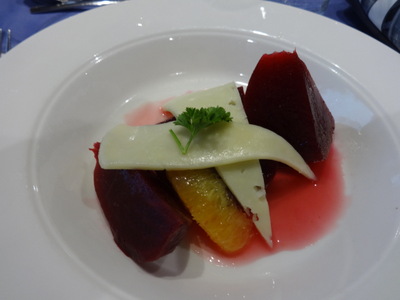
 A little footsore (we'd been looking at art for eight hours, now, with only the break for lunch), we boarded the buses back to the ship for dinner.
A little footsore (we'd been looking at art for eight hours, now, with only the break for lunch), we boarded the buses back to the ship for dinner.
I don't think anyone ordered the Caucasian eggplant roll with Russian cheese and walnuts, the tuna salad with string beans, potatoes, and boiled eggs, or the cream of bell pepper soup. Ev had his usual cheese plate (Roquefort and Brie with apricot chutney) and the rest of us ordered the caramelized beets with goat cheese and oranges. Hilarious. As I mentioned somewhere above, a "caramelerie" in Russia is a store that sells all kind of melted sugar candy, like lollipops and hard candy. The chef had clearly interpreted "caramelized beets" to mean "candied beets," so we got beets stewed in sugar syrup and served with the only goat cheese he had, with the texture and flavor of Havarti.
The right-hand photo shows the red and white wines poured throughout the cruise at dinner, unless you ordered something different (and paid for it).

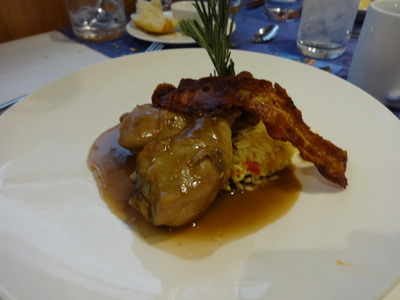 David's main course was honey ginger briased chicken legs with gravy over vegetable rice (left).
David's main course was honey ginger briased chicken legs with gravy over vegetable rice (left).
I chose the fillet of cod in potato crust with ratatouille vegetabesl and sauerkraut sauce. Odd combination, but not bad.
Nobody ordered the vegetable quiche.
For dessert, I think everybody had the vanilla panna cotta with apricot sauce, though I don't seem to have gotten a photo of it. The other choice was mixed forest berry cake.
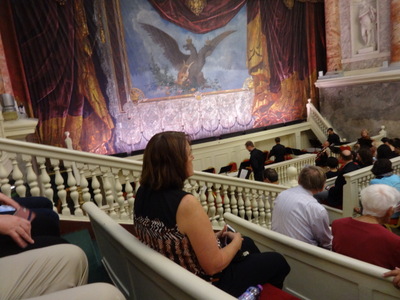 And the day wasn't over yet! We had signed up for a performance of Swan Lake at the Alexandrinsky Theater, and the buses left at 6:45 p.m. I noticed that the description of the excursion said "attend a performance . . . in St. Petersburg, city of Baryshnikov and Nureyev, . . ." but did not actually name the company, let alone the performers we would be seeing. I figured we were getting the second string.
And the day wasn't over yet! We had signed up for a performance of Swan Lake at the Alexandrinsky Theater, and the buses left at 6:45 p.m. I noticed that the description of the excursion said "attend a performance . . . in St. Petersburg, city of Baryshnikov and Nureyev, . . ." but did not actually name the company, let alone the performers we would be seeing. I figured we were getting the second string.
And then, like a dunce, I delayed a little too long in my stateroom and missed the bus! I scrambled through two other ships and emerged on the quai just as the last bus from our ship pulled out of the parking lot. Drat! I threw myself on the mercy of Program Director Margo, who was out there directing traffic, and she got on the phone to the Program Directors of the other ships in port. She was actually able to put me on a bus from the Viking Helgi whose tour escort had a spare ticket. I wound up seeing Swan Lake, but at the Hermitage Theater (the one where Catherine the Great used to make the nobles dress up and perform). Photography during the performance was forbidden, but I got this shot of the stage and curtain before it started.
Back at the ship, Rachel and I compared notes. Yes, definitely second string; good but not inspired. Actually, in the performance I saw, the jester was outstanding, and the young swans were a definite cut above the rest of the chorus.
The restaurant was serving a late-night snack of goulash soup, but I don't think any of us went for it. I know I went right to bed, because we were due back on the buses at 8:15 a.m. the next day.
In our staterooms, though, we each found a copy of a large, hardbound book, courtesy of Viking. It's The Hermitage: The Biography of a Great Museum by Geraldine Norman. Because David and I had separate staterooms, we each received a copy, so we sent one of them home with the Sinnetts for Carolyn. I'm reading it now, and it's wonderful—more a history of Russia from the Hermitage's point of view than just of the museum itself.
Previous entry
List of Entries
Next entry

 On Thursday morning, the scrambled eggs were especially good. Each morning, I would try a little. Some days they were great, others, not worth eating. Clockwise from the top: a minicroissant, a couple of cubes of Canary melon, scrambled eggs, bacon, half a bagel spread with butter and cherry jam, a little cold roast pork, and a small slice of Havarti cheese. At the top right, my pot of tea.
On Thursday morning, the scrambled eggs were especially good. Each morning, I would try a little. Some days they were great, others, not worth eating. Clockwise from the top: a minicroissant, a couple of cubes of Canary melon, scrambled eggs, bacon, half a bagel spread with butter and cherry jam, a little cold roast pork, and a small slice of Havarti cheese. At the top right, my pot of tea.
 Again, the building itself was worth the price of admission before we even looked at the art! This is the Ambassador's Staiorcase in the entry hall and (to the right) its painted ceiling. All the gray "marble" statuary surrounding the central painted panel is "trompe l'oeil," i.e., painted on a flat surface to look three-dimensional. The staircase's design is 18th Century, but the decor was redone in the 19th century after a fire in 1837. The carved wood mouldings were replaced with gilded plaster, and wooden bannister replaced with marble.
Again, the building itself was worth the price of admission before we even looked at the art! This is the Ambassador's Staiorcase in the entry hall and (to the right) its painted ceiling. All the gray "marble" statuary surrounding the central painted panel is "trompe l'oeil," i.e., painted on a flat surface to look three-dimensional. The staircase's design is 18th Century, but the decor was redone in the 19th century after a fire in 1837. The carved wood mouldings were replaced with gilded plaster, and wooden bannister replaced with marble.
 Again, some of the rooms were named for function, but others by decor. I don't remember which this one was, but I think of it as the red room.
Again, some of the rooms were named for function, but others by decor. I don't remember which this one was, but I think of it as the red room.
 In the winter palace, they are thicker and more solid. After the war, they were .resanded and impregnated with a lacquer, so they're much less subject to wear.
In the winter palace, they are thicker and more solid. After the war, they were .resanded and impregnated with a lacquer, so they're much less subject to wear.
 This room is the Armorial Hall. Regilding a room like this takes 7 to 9 kilos of gold leaf. The decor of the palace also uses up to 200 different shades of color of jasper.
This room is the Armorial Hall. Regilding a room like this takes 7 to 9 kilos of gold leaf. The decor of the palace also uses up to 200 different shades of color of jasper.
 Here's a rare wooden altarpiece. Remember, from the monastery tour, that wood carving fell out of favor, so not much of it is left.
Here's a rare wooden altarpiece. Remember, from the monastery tour, that wood carving fell out of favor, so not much of it is left.
 Mosaic tables showed got popular in the middle of the 18th century. This one, made of unbelievably small bits of oxidized metals and glass is displayed in Catherine the Great's private appartments. Another nearby was made of bits of natural stone.
Mosaic tables showed got popular in the middle of the 18th century. This one, made of unbelievably small bits of oxidized metals and glass is displayed in Catherine the Great's private appartments. Another nearby was made of bits of natural stone.


 So in addition to all this decor, we also saw some actual art. At the left here is a boy asleep in the coils of a dolphin, attributed to Lorenzo Lorenzetto.
So in addition to all this decor, we also saw some actual art. At the left here is a boy asleep in the coils of a dolphin, attributed to Lorenzo Lorenzetto. 
 Vases and other decorative and useful objects carved from solid blocks of semiprecious stones were popular, and the place is full of them. Here is a vase in green jasper. At the right is a table top in lapis lazuli.
Vases and other decorative and useful objects carved from solid blocks of semiprecious stones were popular, and the place is full of them. Here is a vase in green jasper. At the right is a table top in lapis lazuli.
 At the left here is a wonderful Canaletto (I love Canaletto).
At the left here is a wonderful Canaletto (I love Canaletto). 
 At the left here is a Rembrandt, Christ and the Woman of Samaria. Nearby is the last (and the largest) painting that Rembrandt ever produced, but it's very dark and difficult to see. They can't restore the bright colors because Rembrandgt covered it with a lacquer that has the same solvent as the paint, apparently a common problem with paintings of this period. The lacquer darkens and can't be removed.
At the left here is a Rembrandt, Christ and the Woman of Samaria. Nearby is the last (and the largest) painting that Rembrandt ever produced, but it's very dark and difficult to see. They can't restore the bright colors because Rembrandgt covered it with a lacquer that has the same solvent as the paint, apparently a common problem with paintings of this period. The lacquer darkens and can't be removed.

 And of course, in addition to all the standard old masters, the Hermitage has ancient art and artifacts. At the left here is a Roman mosaic (probably a floor), and at the right an Egyptian mummy.
And of course, in addition to all the standard old masters, the Hermitage has ancient art and artifacts. At the left here is a Roman mosaic (probably a floor), and at the right an Egyptian mummy. 


 This is the large "square" (actually semicircular) that separates the back of the Hermitage from the front of the long curved General Staff Building, now property of the Hermitage (at least some of it; some may still be in military hands). It also housed the ministry of defense and ministry of finance. This is where the contents of the Hermitage were piled in the snow after being rescued from the fire. Among the tourists strolling around, you can see tanks, military trucks, and antiaircraft guns. You can't see them here, but we also saw structures intended to entangle and disable tanks (looking like 10-foot jacks from the game of ball and jacks). They were all left over from some sort of parade or demonstration a few days earlier, and the military folks seemed happy to have people pose for selfies with them and even climb on the tanks.
This is the large "square" (actually semicircular) that separates the back of the Hermitage from the front of the long curved General Staff Building, now property of the Hermitage (at least some of it; some may still be in military hands). It also housed the ministry of defense and ministry of finance. This is where the contents of the Hermitage were piled in the snow after being rescued from the fire. Among the tourists strolling around, you can see tanks, military trucks, and antiaircraft guns. You can't see them here, but we also saw structures intended to entangle and disable tanks (looking like 10-foot jacks from the game of ball and jacks). They were all left over from some sort of parade or demonstration a few days earlier, and the military folks seemed happy to have people pose for selfies with them and even climb on the tanks.
 The atrium is very large. It was once the open courtyard of the building; now it's glassed over.
Within it are displayed this complicated system of wooden ladders and a life-size metal statue of a young girl in the act of falling out of an overturned chair (right).
The atrium is very large. It was once the open courtyard of the building; now it's glassed over.
Within it are displayed this complicated system of wooden ladders and a life-size metal statue of a young girl in the act of falling out of an overturned chair (right).
 The walls were massive, as this doorway illustrates. The door and the wall it's hinged to are so thick that special "double-jointed" hinges are necessary for them to work at all. Like all buildings in Russia, this one has been put to many uses. Apparently during some restoration or reconstruction, it housed a lot of the construction workers and even livestock.
The walls were massive, as this doorway illustrates. The door and the wall it's hinged to are so thick that special "double-jointed" hinges are necessary for them to work at all. Like all buildings in Russia, this one has been put to many uses. Apparently during some restoration or reconstruction, it housed a lot of the construction workers and even livestock.
 The collection displayed in this building is the other half of the Shchukin and Morozov collection from the Pushkin in Moscow.
The collection displayed in this building is the other half of the Shchukin and Morozov collection from the Pushkin in Moscow.
 Back in the bus for the third phase of our Hermitage tour (another part that the "regular" tour doesn't cover), we learned that the Neva is 74 km long and that 50 miles of it are in the city (why they give the two dimensions in different units, I have no idea). Also, the building next to the gloomy-looking statue of Alexander III was the Museum of Lenin until three days after communism fell. It was packed and emptied and taken over by the Bureau of Museum, which has offices there and occasionally uses it for temporary exhibitions.
Back in the bus for the third phase of our Hermitage tour (another part that the "regular" tour doesn't cover), we learned that the Neva is 74 km long and that 50 miles of it are in the city (why they give the two dimensions in different units, I have no idea). Also, the building next to the gloomy-looking statue of Alexander III was the Museum of Lenin until three days after communism fell. It was packed and emptied and taken over by the Bureau of Museum, which has offices there and occasionally uses it for temporary exhibitions. 
 Our destination was this impressive building, shown here in two views, which houses some of the Hermitage's depositories of objects not displayed in the museum. This building contains 38 depositories, part of a total of 80.
Our destination was this impressive building, shown here in two views, which houses some of the Hermitage's depositories of objects not displayed in the museum. This building contains 38 depositories, part of a total of 80.
 One wall of the lobby was mirrored (concealing agents looking for terrorists? no clue), which David took as an opportunity to smooth down his hair but Rachel and I took as an opportunity for an "old fashioned" selfie.
One wall of the lobby was mirrored (concealing agents looking for terrorists? no clue), which David took as an opportunity to smooth down his hair but Rachel and I took as an opportunity for an "old fashioned" selfie.
 The first course was also already in place: a bowl of outstanding cold borscht (sorry, Viking; yours just doesn't measure up) and a tomato and cucumber salad with mixed fresh herbs. The paper placemat says "Welcome and bon appétit" in many languages, and the seal on it reads "Hermitage" in Roman and Cyrillic.
The first course was also already in place: a bowl of outstanding cold borscht (sorry, Viking; yours just doesn't measure up) and a tomato and cucumber salad with mixed fresh herbs. The paper placemat says "Welcome and bon appétit" in many languages, and the seal on it reads "Hermitage" in Roman and Cyrillic.
 The first storeroom we visited was of paintings. They're hung on these double-sided movable racks. The photo at the right shows a whole stack of racks in "compact" configuration—face to face, without space between. Does Dirac Science Library at FSU still use stacks like these? To view any particular rack, you turn the three-handled wheel to slide the stack open at that point.
The first storeroom we visited was of paintings. They're hung on these double-sided movable racks. The photo at the right shows a whole stack of racks in "compact" configuration—face to face, without space between. Does Dirac Science Library at FSU still use stacks like these? To view any particular rack, you turn the three-handled wheel to slide the stack open at that point.
 In another depository were rows and rows and shelves and shelves of chairs, mixed in with other furniture, including some currently under restoration.
In another depository were rows and rows and shelves and shelves of chairs, mixed in with other furniture, including some currently under restoration.
 A couple of vast rooms were dedicated to carriages and wagons. A second-floor mezzanine exhibited smaller items (saddles, harnesses, bridles, and, yes, about half of an actual mummified horse found in a 4th century burial mound in Siberia) and afforded an upstairs view of the larger items below.
A couple of vast rooms were dedicated to carriages and wagons. A second-floor mezzanine exhibited smaller items (saddles, harnesses, bridles, and, yes, about half of an actual mummified horse found in a 4th century burial mound in Siberia) and afforded an upstairs view of the larger items below.
 The left-hand photo here is of the train only of a gown embroidered with silver—with real, very fine silver wire.
The left-hand photo here is of the train only of a gown embroidered with silver—with real, very fine silver wire.
 A little footsore (we'd been looking at art for eight hours, now, with only the break for lunch), we boarded the buses back to the ship for dinner.
A little footsore (we'd been looking at art for eight hours, now, with only the break for lunch), we boarded the buses back to the ship for dinner.
 David's main course was honey ginger briased chicken legs with gravy over vegetable rice (left).
David's main course was honey ginger briased chicken legs with gravy over vegetable rice (left). And the day wasn't over yet! We had signed up for a performance of Swan Lake at the Alexandrinsky Theater, and the buses left at 6:45 p.m. I noticed that the description of the excursion said "attend a performance . . . in St. Petersburg, city of Baryshnikov and Nureyev, . . ." but did not actually name the company, let alone the performers we would be seeing. I figured we were getting the second string.
And the day wasn't over yet! We had signed up for a performance of Swan Lake at the Alexandrinsky Theater, and the buses left at 6:45 p.m. I noticed that the description of the excursion said "attend a performance . . . in St. Petersburg, city of Baryshnikov and Nureyev, . . ." but did not actually name the company, let alone the performers we would be seeing. I figured we were getting the second string.